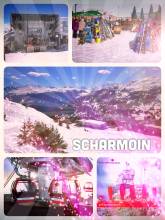Exploring Beautiful Myanmar by Bus
Last country of the Southeast Asian Community
Well, there are many places to do an Indian visa run. And Myanmar by bus is not the best option! The land border between the two countries are closed and the cheapest flight connections go through Thailand
by bus is not the best option! The land border between the two countries are closed and the cheapest flight connections go through Thailand . Flights to Myanmar are comparably expensive and layovers are time-consuming.
. Flights to Myanmar are comparably expensive and layovers are time-consuming.
However, if Myanmar is the last ASEAN (Southeast Asian) country on your travel list, it becomes a legit option.
Before entering India , I managed to travel through all other Southeast Asian nations. So, the country between India and Thailand became my first choice, when my half-year Indian visa expired. With the help of online flight scanners (kiwi.com), I found the best connections and got on a short trip.
, I managed to travel through all other Southeast Asian nations. So, the country between India and Thailand became my first choice, when my half-year Indian visa expired. With the help of online flight scanners (kiwi.com), I found the best connections and got on a short trip.
In order to see more, I decided against a return flight. Instead, I flew into Mandalay and left the country from Yangon. The internet recommended overnight buses to travel within Myanmar. I found many options, so I did not bother much when buying my flight tickets. After all my travels, I feel confident enough to jump on a plane to a new country and not having anything else sorted out.
When boarding the plane, I had nothing but clothes and my travel credit card – no cash, no hotel booking, no bus ticket, and certainly no travel guide. I was looking forward to exploring Myanmar on my own. The plan was to drive from Mandalay to Yangon by bus.
Gazing into the sun at Mandalay
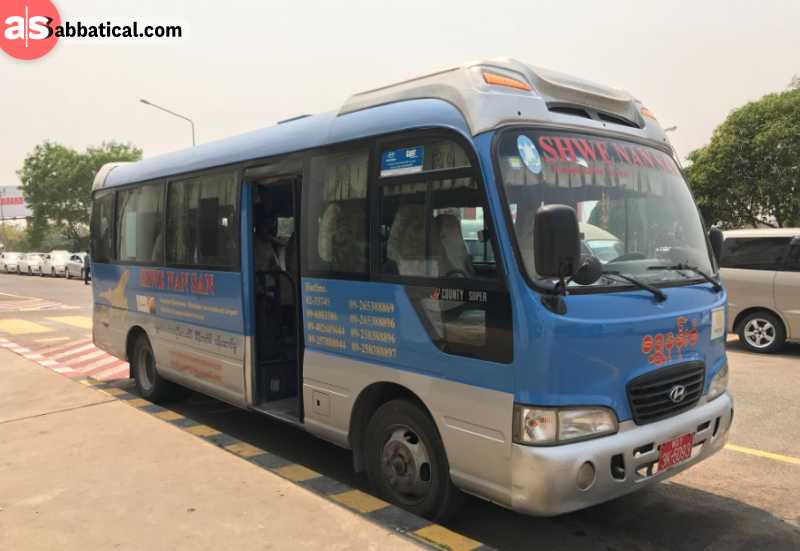
Arriving in Mandalay was rather unspectacular. The airport is small and outside the city. Only private, yet shared shuttle buses transfer visitors directly to their hotels. After making my way to the bus station, I found myself waiting in a small bus together with random other travelers. There is no schedule nor a route. Instead, all the guests just told the driver where they want to go.
To my surprise, the driver remembered every single location and dropped one passenger after the other. Until the car was empty and he shouted the name of my guesthouse – the cheapest place I found online after getting a local sim card at the airport. After checking in to a small room, I rented a scooter and set off to explore the city.

By the time, I was curving through the roads, the sun was already close to the horizon. So, I speed up and tried to do as much sightseeing as possible before darkness. The first Buddhist temple I’ve entered already struck me with its grandiose design and gold decoration. Myanmar’s religious architecture is way more elaborate than in many other Southeast Asian countries.
Planning to visit Mandalay soon, but don't have any idea or itinerary? Don't worry, head over to most interesting things to do in Mandalay and have a blast of a trip!
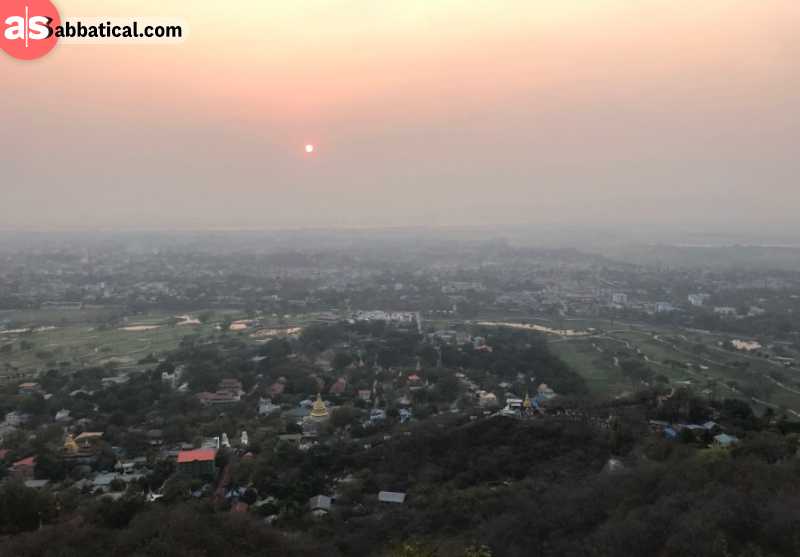
The heart of their temples is usually occupied by a tremendous golden Buddha statue in a lotus position – a truly awe-striking view from the ground. No wonder, they have so many UNESCO protected templates and pagodas. Mandalay also hosts the world largest book: religious inscriptions on a series of white stones, protected by small pagodas.
Myanmar is famous for its sunsets when the sun is glooming like a red fireball just above the horizon. Both nights I spent in Mandalay, I witnessed this from two different iconic spots. The first night, I pushed my scooter to its limit when driving up the Mandalay Hill. It is not the height, nor the smooth asphalt, but the steep ascent along windy curves, that were thrilling for me, yet torture for the machine.

On the peak, a bunch of tourists were lined up to gaze at the red fireball disappearing below the horizon. Certainly, a nice view. Much better, though way more crowded, was next day’s view from the U-Bein bridge. After fighting my way through the masses, I enjoyed the spectacle from a small island in the river.
Back in time to Mingun and Inwa
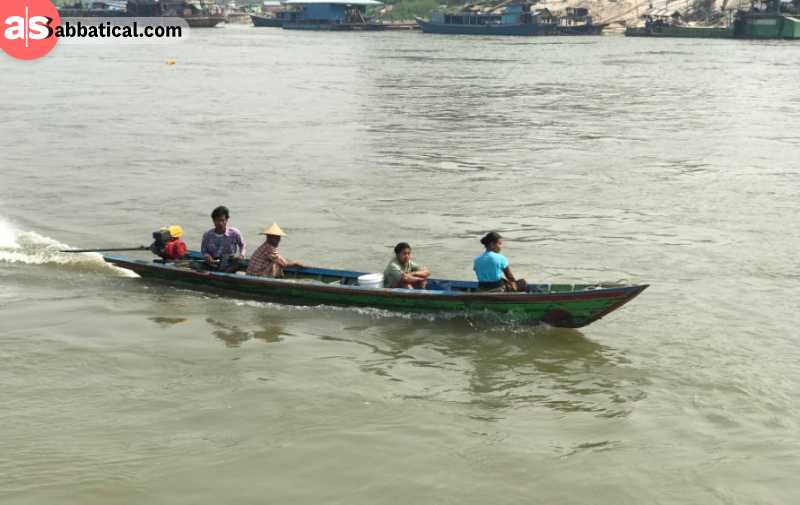
A ferry connects Mandalay with the historic site of Mingun. From Mingun, a scenic road along the river leads down to the town of Sagain, where an iconic steel bridge takes you to the ruins of Inwa, and then back upriver to Mandalay. This round trip is about 50 kilometers and seemed like a perfect day for an independent explorer like me. Until I missed the only ferry!
By the time I found the small harbor, the boat was long gone. Only there, I learned that the ferry leaves every day at 8.30 am and private boats are much costlier. First, I was annoyed by the situation, I stubbornly tried to haggle for a cheaper boat, then I accepted my fate and paid the full price of a private boat to Mingun.
An hour later, I set foot on the other side of the river. In Mingun, I was welcomed by two teenage boys with a modern punk haircut. They helped me to unload my machine over a cranky wooden plank, quite a dangerous activity. They were very friendly, spoke well English and offered their service as tour guides. I was thankful for their help and couldn’t say no.

Mingun is a fairly small place. Its highlight is an enormous, yet unfinished pagoda for the first King of the Burmese Empire. Despite its manmade architecture, it looks like a huge, crumbling rock. A few hundred meters upriver, a white pagoda is tugged away behind trees. This marvelous monument with dozens of small stupas was built for his Queen and is all finished. In between the two pagodas, hangs an enormous bell. According to the guide, the world’s second largest bell – after Moscow.
The basic road along the river took me through small settlements. It was a perfect ride, enjoying the lush scenery, cooling down in the light breeze and greeting villagers. In the hills before Sagaing, more temples and monasteries were waiting for local and international visitors. With a group of Burmese travelers, I tried to have a conversation, using my hands and feet. We didn’t understand everything, but it was a lot of fun.

Sagaing itself doesn’t offer much besides a local market and some refreshing drinks. Inwa, on the other hand, is a major highlight near Mandalay. Spread over a vast area of today’s farmland, a series of historic ruins can be explored. These crumbling buildings and piles of stones are a perfect witness of the past grandeur of the ancient Burmese Kingdom. Late afternoon, most visitors were gone and I felt like a real explorer.
Bagan Hot Air Balloon Adventure

Bagan is righteously Myanmar’s most famous site. It is well known for the world’s most stunning sunsets and highest density of temples and pagodas. Personally, I am torn between Bagan’s exceptional beauty and modern-day tourism. As the country is slowly opening up to the world, more and more travelers are visiting this historic site, traveling Myanmar by bus. Fancy tour buses from Mandalay and Yangon are bringing loads of people.
New hostels are popping up and tour operators are offering convenient packages. Tourism has become the region’s driving force and the local people are slowly jumping on it. The entire area is under UNESCO protection and at the time of my visit, they started to restrict access.
I tried to uncover Bagan’s uniqueness with the help of locals. Instead of following the masses, I wanted to create my own experience. I ended up with a gradual mixture of both worlds, modern commodity blended with domestic flair. The bus from Mandalay to Bagan arrived at an inconvenient time after midnight and forced me to book the first night at a hostel (online).

Get some ideas about unique things to do in Bagan and learn much about the culture and traditions of Myanmar.
The next morning, I moved to a local guesthouse down the street. For about half the price, I got a large room with a shower for myself – without all the fancy stuff though. In Old Bagan, I learned about the Burmese traditional lacquerware. I enjoyed the open museum, where you can see local craftsmen going through all the manual steps and building decorative pots and vases.
Bagan is packed with ancient temples and pagodas. You can drive around for days and still find more hidden treasures. In order to see more in a shorter time, I booked a sunrise Balloon over Bagan ride. I’m not sure if the high price is really justified, but I enjoyed my first flight in a hot air balloon ever. Hovering majestically a hundred meters above the ground and moving slowly from one temple to the next, was a unique experience.
After getting the full overview, I explored Bagan’s vastness on an electric scooter. Cruising through the dry bushes, hunting for the most special temples is even more exciting. A local boy helped me to find my way and showed me the best spots to visit. After the recent earthquake, many temples are crumbling and require some restoration.
Bagan to Yangon Bus Drive
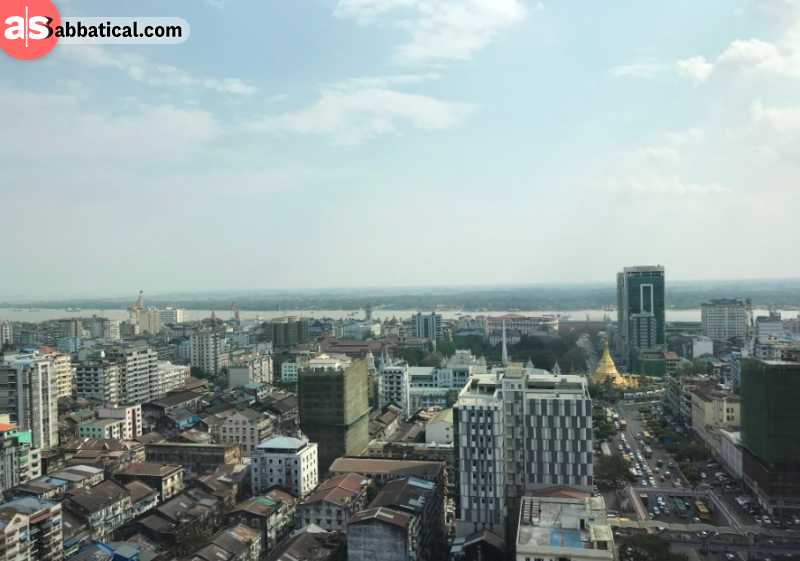
Yangon is Myanmar’s most important city and political capital. This was not always the case, but a rather recent development initiated under British rule. Yangon River is the city’s lifeline, offering a safe harbor with direct access to the Indian Ocean. Its position has helped Yangon to develop faster than the rest of the country and to shape a modern skyline. After seeing Myanmar’s rural lifestyle, I was surprised to find myself sipping a Café Latte in a modern sky bar, overlooking crowded streets.
Further down to the riverfront, a series of colonial British buildings are decorating the roads. Few of them were artistically restored and shining like new, while others are crumbling and rotting away. Both states of architecture have their own charm and are attracting many gazes.

If you are a faint-hearted traveler, stop there at the Northern Waterfront. The Yangon River not only represents economic growth but also reveals the struggle of the Burmese people. The land South of the river is struck with extreme poverty. They are lacking supplies and support from the wealthy city. Instead of a bridge, their only way into the city is a ferry. I was extremely lucky to be able to discover the ferry and the townships of Dala.
Yangon is the old capital of the country and has so many diverse places to visit and things to do.
A local boy literally dragged me from the shiniest point in the city to the shabby ferry terminal. Without knowing what to expect on the other side, I hesitantly followed him. It took me a while to comprehend the severity of the situation. Yangon’s Southern area was struck by a Tsunami in 2008 and has still not recovered. Over there, the people are living in extreme poverty, having to carry water from a pond.
Like the rest of Burma, Yangon has a long history. Besides recent modernization and tragedy, you can still find traditions and peace. The culmination of this is manifested in the golden pagoda, perfectly placed on the highest hill. Shwedagon Pagoda is not only hosting important Buddhist relics but has become the religious center for millions. On my short visit, I was overwhelmed by the sheer number of shrines and temples built around the main pagoda. Hundreds of people were praying and singing in independent groups.
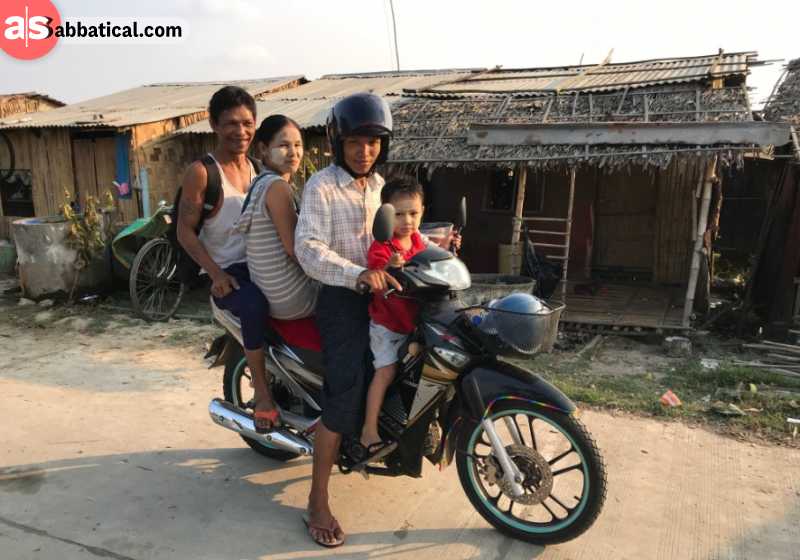
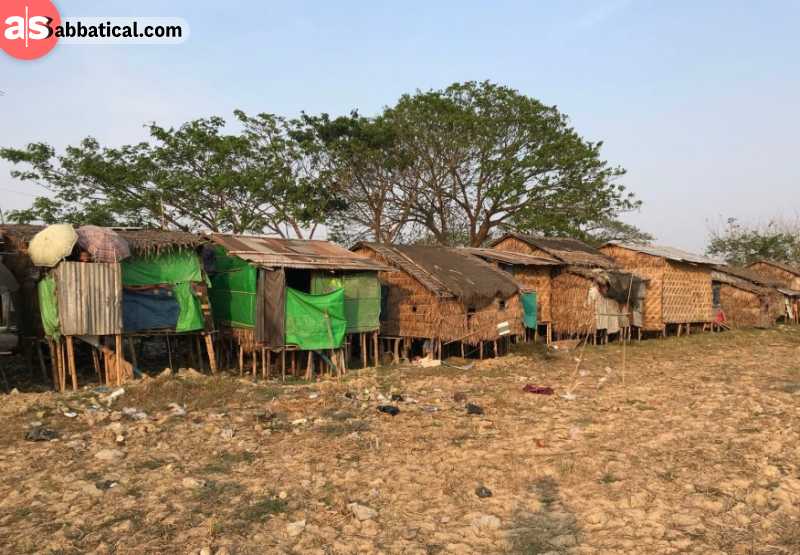
I needed a break and sat down on a quiet stair. After a short moment, a young monk sat next to me and started to talk. We had a great conversation about our world, spirituality and the universe. In the end, he surprised me with a personal gift, he bought me a book about the Science of Buddhism.
Great time to visit Myanmar by bus
Myanmar is slowly opening its doors and inviting foreigners. I have only heard good things about the country and was curious to experience it first-hand. What was meant as a short trip to renew my Indian Visa, ended in a great adventure. I have only touched the surface of the Burmese people and culture but was struck with beauty and hospitality. Every single person I met on my journey, was happily smiling and open for a conversation.
As the country is slowly seeing more tourists and wealth, it could slowly lose its unique identity and positive attitudes. It was a perfect time for me to visit the country. They already have a viable infrastructure, yet are not overrun by global business or tourism. Hopefully, they can grow steadily, supporting the people and culture.
I can only recommend everyone to visit Myanmar by bus today. At the same time, I urge you to dive into their culture, trying to understand them, instead of looking for global commodities or extravagant resorts. The Burmese people still carry their naturally beautiful, unspoiled by globalization. One example of this is their natural makeup and sunscreen. Instead of industrial products, girls beautify and protect their skin with the yellow powder of the star flower tree – a unique picture!
Looking for more travel ideas while you're in Myanmar? Here you can read about off-the-beaten-path destinations in Myanmar!
Young and old people still start talking to you, for no reason other than curiosity. It is so great to have a genuine conversation with people from a foreign place, without having a commercial interest. Myanmar is truly an amazing country.
Great thanks to the Buddhist monk for the inspiring conversation and the present!

My waypoints on this journey
-
Mandalay
royal capital of Myanmar (Burma) and home to many Buddhist pagodas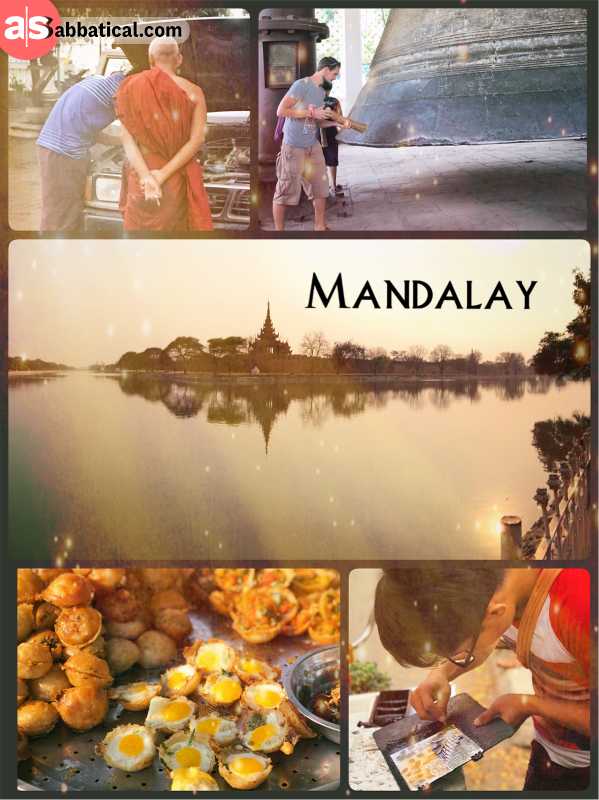
Location:
Mandalay, Myanmar (Burma)Duration:
Tuesday, March 6, 2018Personal highlights
- Mandalay: royal capital of Myanmar
 (Burma) since 1857
(Burma) since 1857 - Mandalay Roads: renting a scooter and driving around
- Mandalay Hill: watching the sunset from the Su Taung Pyae Pagoda
- Temples: Kyauktawgyi Pagoda, Kuthodaw Pagoda, Shwenandaw Kyaung
- My trip: flying to Mandalay from New Delhi via Thailand
 to renew my India
to renew my India Visa
Visa
Image sources
- Monk with mechanical issues
- Me hitting a very large bell
- Royal Palace Mandalay
- Street food in Mandalay
- Street artist in Mandalay
- Mandalay: royal capital of Myanmar



